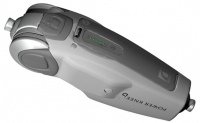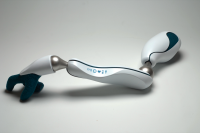I got a couple of e-mails from Jesse over at Martial Arts Explorer this week (check out his blog, it’s awesome!), and one of them linked to a recent post over on Engadget, a site that I had totally forgot to check out on a semi-regular basis for cool new developments for prosthetic limbs. The post in particular he pointed me to was Ossur’s new (v2 I guess) Power Knee:

Engadget’s writeup can be found here, and Ossur’s press release on their website can be found here. This awesome piece of tech got me to thinking about technology and limbs and stuff, and how the landscape continues to change and evolve over time. The first time I ever saw some technology beyond the basic socket + hinge-knee + rubber foot was back in… 1993 I think, when I was 11. I was having one of my usual visits to my specialist with my Dad, and one of the guys who looked after my leg showed my Dad and I this video on these crazy new knees that had hydraulics inside them to do all sorts of cool stuff. At this time we didn’t have the money to go this route, and since I was so young anyway, the money spent would have been devoured since you’d require constant upgrades to the knee as I grew older. The idea never went away though 🙂
In 2000 I got my first hydraulic knee thanks to my folks, as I made my first leap beyond my conventional prosthesis into something a bit more contemporary. I’d finished growing by that point, so I made the move from a loose socket to a suction one, ditched the molded plaster lower-leg for a titanium rod with a foam cover, and moved from a free-swinging hinge to a hydraulic unit. The change was absolutely enormous, it really was huge. Moving away from the belt mechanism that used to hold my leg onto my body was a bit tricky at first, but there’s no comparison to a good suction leg, and I’ve had one ever since. I’m no longer using a hydraulic knee as I find my current pneumatic one a better fit for me – it’s more reactive and stable so its prefect for martial arts training, and more importantly its supported by the government, so it isn’t costing me anything in terms of upkeep or replacement. Without government support, the unit would be setting me back $2000, and I hate to imagine how much I’d be costing if maintenance wasn’t covered as part of it. One thing Australia has so right is its universal health care system, and I’m continuously thankful that the government continues to support amputees and look after us.
But I’ll leave my own tech for a post some time in the future – I want to talk about some of the cooler stuff out there. I was lucky enough to get a test-drive of Otto Bock’s awesome C-Leg a few years back, if only for maybe half an hour, and the thing was just amazing. Within 5 minutes I was jogging around, climbing up and down ramps and stairs, walking over gravel and uneven slopes, and the feeling was just… unbelievable. Unfortunately the price is well and truly beyond our means ($40k – $60k I think is the figure you’re looking at), and while it would be awesome to have one, to be quite honest I’m a bit pragmatic when it comes to large sums of money, and if I had $40k – $60 up my sleeve, I’d rather put it on my mortgage and continue with my current setup on my prosthesis – if it ain’t broke, I guess why fix it????
Still, it’s an awesome piece of kit!
Still on the topic of cool of cool tech, I found the following on Engadget as well:


To quote the source, “The concept “immaculate” from Hans Alexander Huseklepp explores the idea of turning a handicap into a high-performance, cybernetic fashion statement”. Seriously, if this is the future of limbs, sign me up, that’s awesome. I think the idea that they talk about in the original article that Engadget reported on (playmedesign, click here for the story and more pics) is to look at a prosthesis not as a substitute, but an opportunity and a fashion statement. One of the comments on the playmedesign website quotes the following:
“As of today prosthetics are technological skeletons covered in silicone. They imitate the look of a natural arm perfectly, but as soon as someone touches it one realize it’s a prosthetic. The consequence is then a phenomenon researchers call “The Uncanny Valley”, whereas something is so lifelike the realization of it being artificial leads to shock and revulsion”
And you know what, I like that rationale. When I was younger, I never used to like wearing shorts (well, once crazy pubescent self-consciousness hit anyways, so from about the age of 12 onwards), because the leg was so obviously fake. When I started going out with my then-girlfriend (now Wifey), she eventually got me into thinking about trying to wear shorts again (you know, ’cause it kinda gets warm here in Australia during summer :P). I figured that if I was going to do this, I’m going to make a statement, be proud and unobtrusive, and remove the foam padding that wraps around the titanium pole. Was a bit weird at first, but it now feels natural to wear it like that with the titanium pole exposed (it’s also better for movement, gives the knee a bit more free movement). I still use the foam padding when wearing trousers/jeans to assist in protecting the material and keeping the shape that the material’s been cut for, but when I wear shorts, the foam padding comes off. It was actually quite liberating (and still is) to do this, and while you get plenty of looks (especially from the kids, which is all good because that’s the beauty with kids, they’re just curious and I think that’s awesome), it’s never thrown off my confidence.
… and with that, I’m going to wrap up this essay 😛 If you’re keen on keeping up with what’s being tagged on Engadget, I’ve made a direct link to all their prosthesis news items here, and have also added it to the links in the sidebar. Again, big thanks to Jesse for sending through the links that got me onto Engadget and inspired this post – cheers mate!
Bloginated Saturday, 25th April 2009 / Prosthesis or amputee stuff
Tag-isms: new technology | prosthesis







